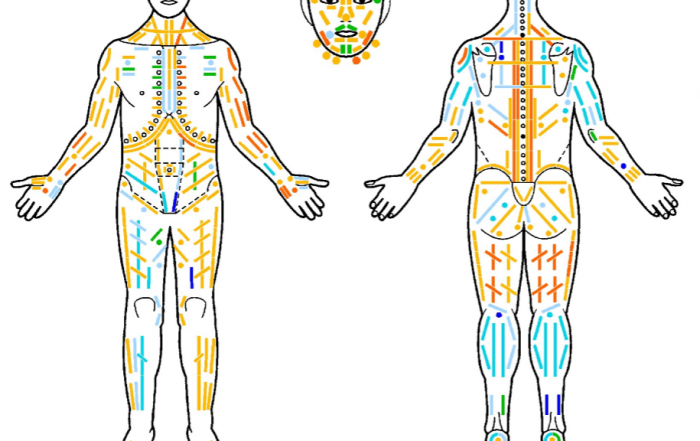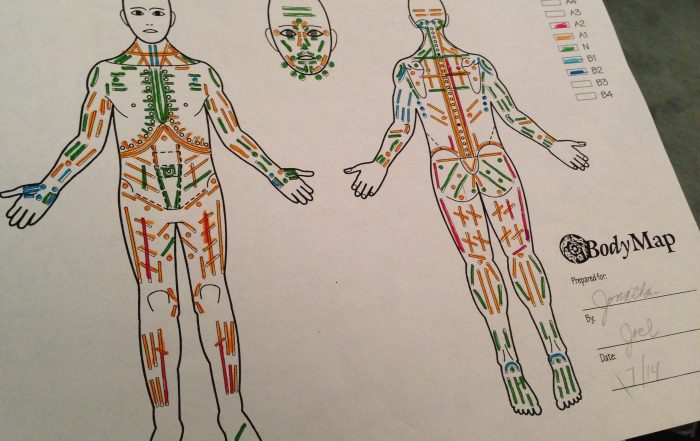AN EXCEPTIONALLY PRECISE TOOL FOR PSYCHOLOGICAL ASSESSMENT AND PSYCHOTHERAPY
The ultimate working tool in the Bodynamic System is the Bodymap, an elaborate and precise chart of both resources and blockages in the client’s body, mapped in terms of patterns of elastic response in the muscles and fasciae, and correlated precisely with psychological content. Based on palpation of over 125 muscles (and/or pairs of muscles), the Bodymap is used as a comprehensive aid for evaluating the client’s personality, and offers a unique overall picture of childhood development, Character Structure, and the Ego Functions considered in Bodynamic Analysis. The Bodymap also helps the therapist to project how the client might benefit from different kinds of therapy.
As Bodynamic Analysis evolved, in the early 1970s Lisbeth Marcher and her close team of associates produced and processed approximately 10,000 reports with specific sets of data from therapy sessions involving adults, and parallel observations involving child development. This work was later followed up and refined on the background of the practical experiences of all senior members of the Danish Institute. This basic empirical research forms the foundation of the knowledge we have put into our Bodymap model.
Bodynamic Analysis advanced and refined its knowledge of muscle response along with physical and psychological development in childhood to such great extent that a new challenge appeared: innumerable bits of data about the response patterns of individual muscles and of related groups of muscles; the correlations of hundreds of muscle responses in the body; their role in physical and psychological development, as reflected in the Character Structures and Positions, and in the Ego Functions; their effects on the psychotherapy process and progress of adult clients; all that information had become so extremely rich and complex that it required new forms of organization, or else its very richness would make the information unusable to any but a few super-experts.
The Bodymap was created in response to those mountains of primary data, as an overall method but also individually for every client. The Bodymap allows psychology and physiology data concerning each individual client to be organized on a single chart that includes a front view of the human body, a back view, and a face-on view of the head. The map illustrates over 125 “testing points” on each side of the human body (left-right) and uses 9 different colours, mostly on the scales of red and blue, to illustrate the qualitative aspects of response of individual muscles, parts of muscles and fasciae, and the corresponding psychological content. Using this test it is possible to pinpoint the age at which psychological problems have their roots. Furthermore it is possible to identify Shock Trauma and Post Traumatic Stress Disorder.
“We map patterns of restrained, collapsed, and healthy impulses occurring at each developmental age level and assist clients build a new sense at the deepest layers of their beings” says Lisbeth Marcher, founder of Bodynamic Analysis.
Personality testing with the Rorschach projective test and the Bodymap – research that helped establish the validity of the Bodymap
The Bodymap also serves as a very accurate personality test particular to the Bodynamic System. A pilot study at one of the Trauma Clinics connected to a research hospital in Denmark set out to compare the results of four different tests and methods often used for psychological evaluation of psychiatric and psychotherapy patients, against the results obtained using the Bodymap. One of the other assessment methods examined was the Rorschach projective test. The results of the study showed some very interesting correlations:
• The assessments obtained from Rorschach and from the Bodymap showed a high degree of compatibility, greater than any other two assessment methods;
• The Rorschach turned up to be more accurate than the Bodymap in the assessment of cognitive development and associative processes;
• The Bodymap was able to offer more precise and detailed information than the Rorschach about the development of the client, about the age when each of his/her problems arose, and also precise information with which to identify Shock Trauma;
• Overall, the Rorschach and the Bodymap turned out to be the two most reliable assessment methods, as confirmed by assessment of the same patients in the course of therapy.
The Bodymap in the Psychotherapy Process
At first sight the Bodymap appears like a complicated proposition; indeed, today a detailed analysis of an individual Bodymap is performed by computer using specialized software that organizes the responses of hundreds of individual muscles in terms of Character Structures, Ego Functions, Shock Trauma–PTSD and several other factors. A Bodynamic analyst can use her/his client’s Bodymap as a constant reference that offers invaluable information at every stage of the psychotherapy process. For example: the Bodymap allows the analyst to pinpoint the development age-stage in which a psychological problem has its roots; to identify Shock Trauma and PTSD and correlate these to age (Character Structure – see above) and behavioural traits (Ego Functions – see above), thereby formulating more educated hypotheses to help direct the process.
The Bodymap offers a unique highly accurate method for psychological evaluation, since it applies a client-neutral instrument to review how clients are changing, rather than rely on the client’s verbal description of her-his experience of change. Bodymap testing every two years (on average) reveals very precise information about the actual progress of psychotherapy.
It is important to note that in order to get this precise knowledge as therapists, a huge part of the training in the Bodynamic System is devoted on learning and training the precise anatomical movements of the muscles in the body – an area where we depend on different anatomical atlases, manuals and books used by other professional systems (medicine, physiotherapy et al.), supplemented by our own literature.
Blog Articles on the Bodymap
Bodymap Testing & Interpretation
A central hypothesis in Bodynamic Analysis concerns the time period in which individual muscles come under voluntary control. There is observed to be a critical time period in which they acquire an imprint. This imprint is not simply about physical strength or kinesthetic ability. It concerns the psychological content or issue associated with the activity or function of this muscle. Thus the muscle encodes or "remembers" what happened in the emotional/ psychological environment in the time period in which it came under conscious control.
The Bodymap – A precise diagnostic tool for Psychotherapy
In this article we introduce readers to the Bodymap, a precise diagnostic tool developed as a part of Bodynamic Analysis. The Bodymap is a concise visual format for displaying and analyzing psychological information stored in the muscles. The ability to measure muscle responses and access the historical information they contain makes a developmental analysis in terms of psychological character structures more concrete and less metaphorical. We also introduce ten “Ego Functions” (e.g. grounding and reality testing, centering, etc.) that are used to understand human functioning.
Bodymap Reading & Interpretation
In Bodynamic Analysis, we use a Bodymap as a starting point for the evaluation of the personality of the client. It also helps us find out how they might benefit from different kinds of therapy. On the Bodymap form, which is a drawing of a figure of the human front and backsides, we make a color-coded depiction of the muscle responses of almost all the muscles of the client. By muscle response, we mean the elasticity of each muscle, as measured by palpation. We differentiate nine degrees of response: 4 degrees of hypo-response, 4 degrees of hyper-response, and 1 neutral response.



